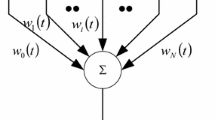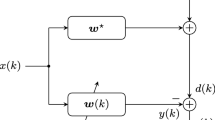Abstract
This paper presents a neural network-based Lyapunov energy function for the weighted least-squares design of IIR all-pass filters. In the proposed method, the error reflecting the difference between the desired phase response and the phase of the designed IIR all-pass filter is formulated as a Lyapunov error criterion. Based on the neural network architecture and suitable Hopfield parameters, the optimal filter coefficients can be obtained when convergence is achieved. Furthermore, a weight updating function is proposed to achieve accurate approximation of the equiripple response. The simulation results indicate that the proposed technique can achieve high performance in a parallel manner.








Similar content being viewed by others
References
D. Bhattacharya, A. Antoniou, Real-time design of FIR filters by feedback neural networks. IEEE Signal Process. Lett. 3(5), 158–161 (1996)
D. Bhattacharya, A. Antoniou, Design of equiripple FIR filters using a feedback neural network. IEEE Trans. Circuits Syst. II, Analog Digit. Signal Process. 45(4), 527–531 (1998)
S. Bilbao, Time-varying generalization of all-pass filters. IEEE Signal Process. Lett. 12(5), 376–379 (2005)
S.C. Chan, H.H. Chen, C.K. Pun, The design of digital all-pass filters using second-order cone programming (SOCP). IEEE Trans. Circuits Syst. II, Express Briefs 52(2), 66–70 (2005)
C.K. Chen, J.H. Lee, Design of digital all-pass filters using a weighted least squares approach. IEEE Trans. Circuits Syst. II, Analog Digit. Signal Process. 41(5), 346–351 (1994)
J.A. Freeman, D.M. Skapura, Neural Network-Algorithms, Applications and Programming Techniques (Addison-Wesley, Reading, 1991)
K. Gao, M.O. Ahmad, M.N.S. Swamy, Neural LS estimator with a non-quadratic energy function, in Proc. of Int. Conf. on ICASSP, Apr. 1991, pp. 1041–1044
J.J. Hopfield, D.W. Tank, Neural computation of decision in optimization problems. Biol. Cybern. 52, 141–152 (1982)
M. Ilehara, M. Funaishi, H. Kuroda, Design of all-pass networks using Remez algorithm, in Proc. IEEE Int. Symp. Circuits and Systems, Jun. 1991, pp. 364–367
Z. Jing, A new method for digital all-pass filter design. IEEE Trans. Acoust. Speech Signal Process. 35(11), 1557–1564 (1987)
Y.D. Jou, Design of real FIR filters with arbitrary magnitude and phase specifications using a neural-based approach. IEEE Trans. Circuits Syst. II, Express Briefs 53(10), 1068–1072 (2006)
Y.D. Jou, Design of two-channel linear-phase quadrature mirror filter banks based on neural networks. Signal Process. 87(5), 1031–1044 (2007)
Y.D. Jou, F.K. Chen, L.C. Su, C.M. Sun, Weighted least-squares design of IIR all-pass filters using a Lyapunov error criterion, in 2010 IEEE Asia–Pacific Conference on Circuits and Systems, Dec. 2010, pp. 1071–1074
S.S. Kidambi, Weighted least-squares design of recursive all-pass filters. IEEE Trans. Signal Process. 44(6), 1553–1557 (1996)
S.S. Kidambi, Closed-form approach to design of all-pass digital filters using cepstral coefficients. Electron. Lett. 40(12), 720–721 (2004)
T.I. Laakso, V. Valimaki, M. Karjalainen, U.M. Laine, Splitting the unit delay: tools for fractional delay filter design. IEEE Signal Process. Mag. 13(1), 30–60 (1996)
M. Lang, T.I. Laakso, Simple and robust method for the design of allpass filters using least-squares phase error criterion. IEEE Trans. Circuits Syst. II, Analog Digit. Signal Process. 41(1), 40–48 (1994)
M. Lang, All-pass filter design and applications. IEEE Trans. Signal Process. 46(9), 2505–2514 (1998)
J.H. Lee, Y.H. Yang, Design of two-channel linear-phase QMF banks based on real IIR allpass filters. IEE Proc., Vis. Image Signal Process. 150(5), 331–338 (2003)
Y.C. Lim, J.H. Lee, C.K. Chen, R.H. Yang, A weighted least squares algorithm for quasi-equiripple FIR and IIR digital filter design. IEEE Trans. Signal Process. 40(3), 551–558 (1992)
R.A. Losada, Digital Filters with MATLAB (The MathWorks Inc., Natick, 2008)
V.M. Mladenov, N.E. Mastorakis, Design of two-dimensional recursive filters by using neural networks. IEEE Trans. Neural Netw. 12(3), 585–590 (2001)
T.Q. Nguyen, T.I. Laakso, R.D. Koilpillai, Eigenfilter approach for the design of allpass filters approximating a given phase response. IEEE Trans. Signal Process. 42(9), 2257–2263 (1994)
A.V. Oppenheim, R.W. Schafer, Discrete-Time Signal Processing (Prentice-Hall Inc., Englewood Cliffs, 1989)
S.C. Pei, J.J. Shyu, Eigenfilter design of 1-D and 2-D IIR digital all-pass filters. IEEE Trans. Signal Process. 42(4), 966–968 (1994)
S.C. Pei, P.H. Wang, Maximally flat all-pass fractional Hilbert transformers, in Proc. IEEE Int. Symp. on Circuits and Systems, May 2003, pp. 701–704
K. Rajamani, Y.S. Lai, A novel method for designing allpass digital filters. IEEE Signal Process. Lett. 6(8), 207–209 (1999)
P.A. Regalia, S.K. Mitra, P.P. Vaidyanathan, The digital all-pass filter: a versatile signal processing building block. Proc. IEEE 76(1), 19–37 (1988)
D.W. Tank, J. Hopfield, Simple neural optimization networks: an A/D converter, signal decision circuit, and a linear programming circuit. IEEE Trans. Circuits Syst. 33(5), 533–541 (1986)
C.C. Tseng, Design of IIR digital all-pass filters using least pth phase error criterion. IEEE Trans. Circuits Syst. II, Analog Digit. Signal Process. 50(9), 653–656 (2003)
X. Zhang, T. Muguruma, T. Yoshikawa, Design of orthonormal symmetric wavelet filters using real all-pass filters. Signal Process. 80(8), 1551–1559 (2000)
X. Zhang, H. Iwakura, Design of IIR digital all-pass filters based on eigenvalue problem. IEEE Trans. Signal Process. 47(2), 554–559 (1999)
H. Zhao, J. Yu, A novel neural network-based approach for designing 2-D FIR filters. IEEE Trans. Circuits Syst. I, Fundam. Theory Appl. 44(11), 1095–1099 (1997)
Acknowledgements
The authors would like to thank the editor and anonymous reviewers for their valuable recommendations and comments, which contributed to an effective presentation of the proposed paper. The work was supported in part by the National Science Council of the Republic of China under research contracts NSC-99-2221-E-145-001 and NSC-100-2221-E-145-005.
Author information
Authors and Affiliations
Corresponding author
Appendix
Appendix
The tangent expression of (5) is rewritten as
Multiply both sides by \(\cos [ \rho_{d} ( \omega ) ] ( 1 + \sum_{n = 1}^{N} a_{n}\cos ( n\omega ) )\); hence,
Then, (27) can be formulated as
Using the properties of the trigonometric function, (28) can be expressed in a compact form:
This equation is analogous to the general FIR filter design problem, in which the constant amplitude response is replaced by the sinusoidal amplitude. Consequently, there exist several linear algebra-based methods that can be used to solve this optimization problem.
Rights and permissions
About this article
Cite this article
Su, LC., Jou, YD., Chen, FK. et al. Neural Network-Based IIR All-Pass Filter Design. Circuits Syst Signal Process 33, 437–457 (2014). https://doi.org/10.1007/s00034-013-9641-0
Received:
Revised:
Published:
Issue Date:
DOI: https://doi.org/10.1007/s00034-013-9641-0




